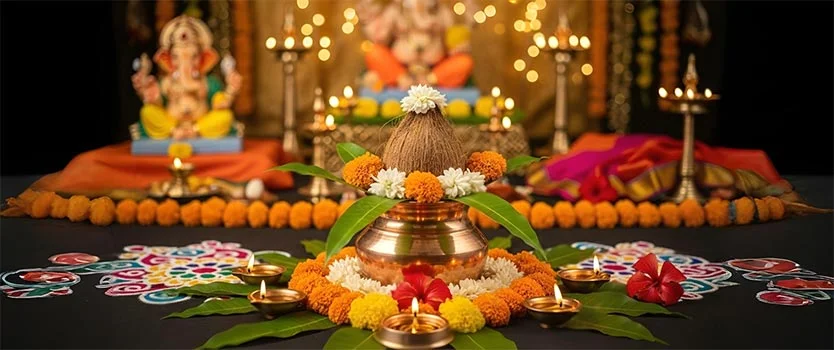
Kalash Pujan is a very warm and effective tradition in Hinduism. A Kalash is a holy vessel – usually made of brass, copper, or clay – filled with water, with mango leaves and a coconut on top. There is so much meaning behind this small setup. It is used by people in various rituals to invite divinity, bless a new residence, and celebrate festivals. The Kalash is believed to carry the energy of gods and goddesses. It is seen as a symbol of good luck, purity, and protection. Families often decorate it beautifully to show respect and devotion. Performing Kalash Pujan is said to bring peace, happiness, and prosperity into the home.
There is nothing complicated, but it represents a lot of life. A Kalash brings the blessings of heaven to your home.
Kalash Pujan has its roots in ancient times. In the Vedas, the pot is described as a symbol of life and plenty. The Kalash played a major role in many a Hindu Puja, like Griha Pravesh (housewarming), Navratri, and Diwali festival worship.
Throughout India, traditions may differ, but the message is the same: Kalash invites divine and good energy. It’s considered as a tiny universe, having the five elements in it (earth, water, fire, air, space) and the blessings of the gods.
Together, these items make the Kalash a living symbol — a small, blessed world ready to receive divine grace
Kalash Pujan is not just a ritual; it is a means to introduce a calmer, spiritual energy into an occasion. The Kalash is seen as a universal womb — a source of blessings and protection. Performing pujan makes people feel a part of the divine energy and helps them to connect with the purpose in their lives.
Kalash Pujan is the gathering of families and communities. It celebrates significant occasions of a new house, the onset of any festival. It helps to transfer the culture and practices to the generations.
The act of preparing and performing the Kalash Pujan helps calm the mind. The ritual brings order, direction, and a sense of calm. It will lessen the stress and improve emotional stability.
Here is a basic step by step kalash pujan vidhi for beginners. Prepare your goods and follow with a clean heart.
Many families use short sacred lines to invite blessings. Here are two simple examples you can use:
You may also chant Vedic hymns or the names of the god you are praying. If you prefer, a simple heartfelt prayer in your language also works very well.
Each region has a different style of Kalash Pujan. Here are some examples:
According to Vastu Shastra, a Kalash has the power to harmonize the five elements (Pancha Mahabhutas) and bring harmony into a place. It is believed to act as a protective shield of negative energy by keeping a decorated Kalash at the main entrance of the home during puja.
During Griha Pravesh Puja, the pujari usually recommends placing the Kalash with water and coins at the main door of the house as a sign of wealth, well-being, and good luck.
Other than spirituality, there may also be a scientific view of the Kalash Pujan. Kalash water takes the positive vibrations of mantras and prayers. When sprinkled throughout the house following the pujan, it cleanses the atmosphere that remove stress and negativity. Mango leaves naturally release oxygen, while coconut water is considered a natural purifier.
Other than festivals, Kalash Pujan is an important component of Yagyas, marriages, and Satyanarayan Katha. The Kalash is placed in front of the fire altar at the Yajna as an observer of the religious rituals.
In weddings, it is a symbol of the unity of two people under divine protection. In a similar way, in Satyanarayan Katha, the Kalash is considered the seat of Lord Vishnu, and his worship is done with love.
Kalash Pujan is a beautiful ritual that combines symbolism, devotion, and culture. You can use it as a welcome home performance or during the main festivals. The Kalash has the power to add spiritual blessings to your life.
With a basic mantra such as a Sanskrit kalash pujan mantra, knowing basic kalash pujan vidhi, and keeping the Kalash in the appropriate direction. You seek peace, prosperity, and spiritual protection. You are blessed at the puja, and as a token of that blessing, the coconut in the kalash becomes prasad.
If you want to perform a kalash pujan in the right way or know more about its benefits, you can consult with our astrologers for guidance.
Author : Sadhana